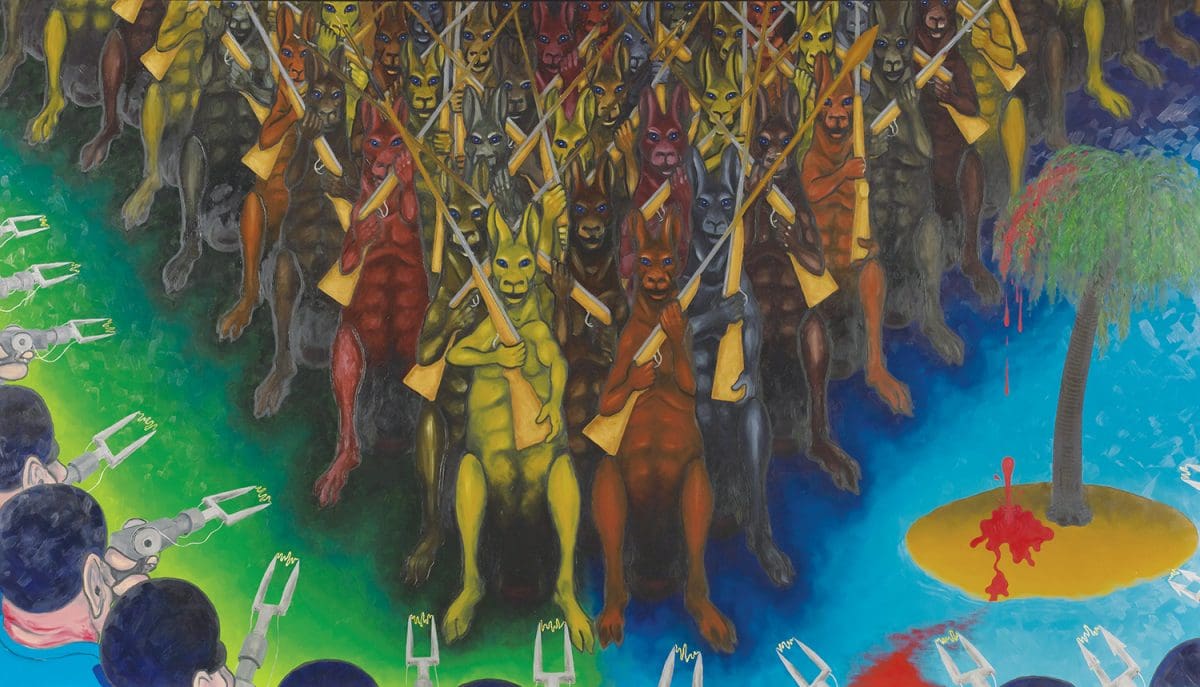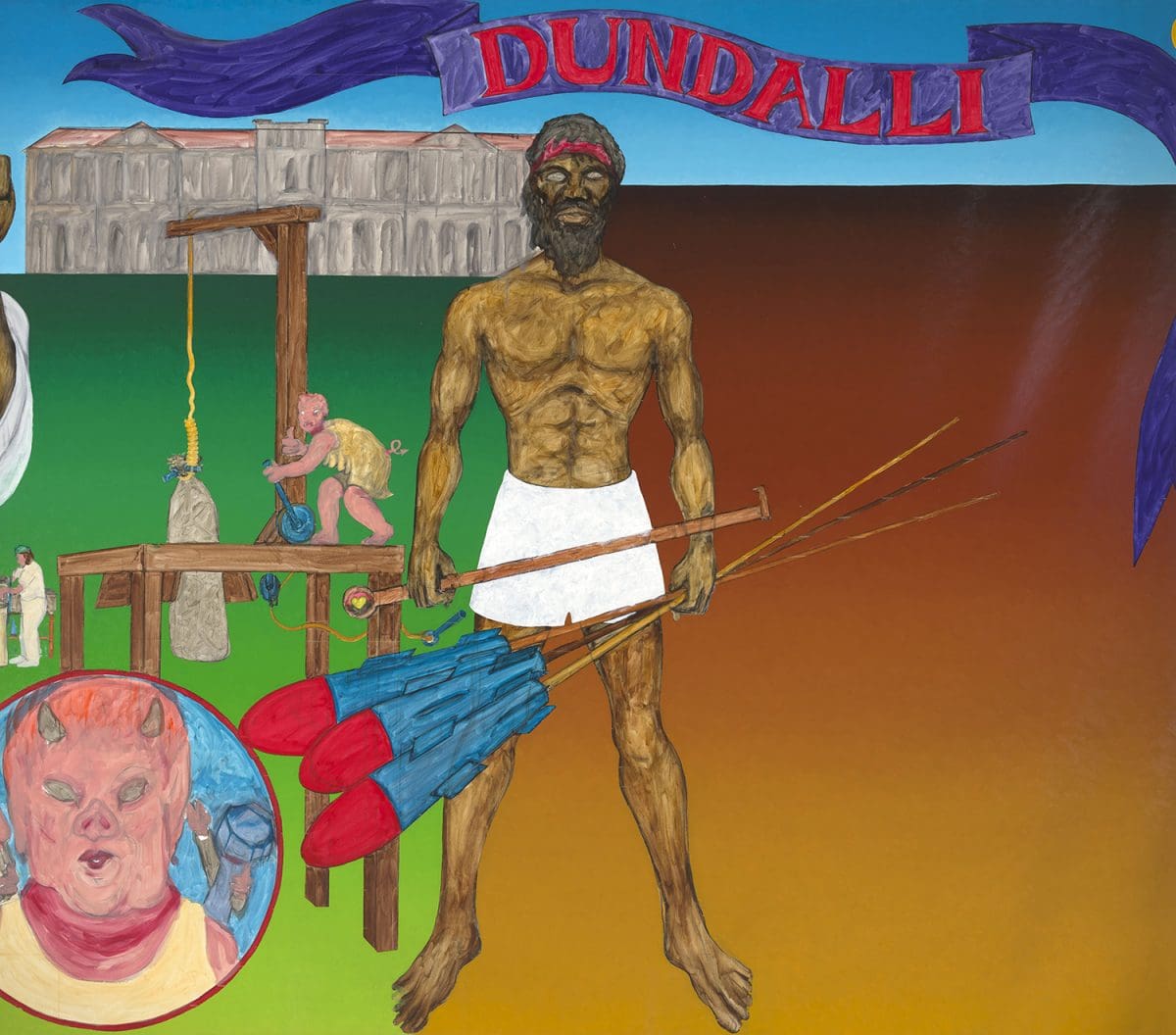
Making Space at the Table
NAP Contemporary’s group show, The Elephant Table, platforms six artists and voices—creating chaos, connection and conversation.



Murriland exists on multiple planes. It is both a real place—the unceded Country of the Murri people, which includes most of what is now known as Queensland and part of north-west New South Wales—and an imaginative, contested territory made manifest in the work of Murri artist Gordon Hookey.
In the Brisbane artist’s two epic Murriland! paintings—shown together for the first time in the current Asia Pacific Triennial at QAGOMA—and across Hookey’s broader oeuvre, Indigenous heroes are given their due. Here, kangaroos aren’t cuddly plushies for tourists or sycophantic pets like Skippy. Hookey’s kangaroos have attitude: they sport dark shades and sixpack abs. These Indigenous warriors are strong, defiant and heavily armed. Alongside historical human freedom fighters, they resist the lie of terra nullius.
All of Hookey’s artwork is a political act of resistance. He is known primarily as a painter, but he doesn’t confine himself exclusively to that medium. As a veteran member of key Indigenous collectives Boomalli (established in Sydney, 1987) and proppaNOW (formed in Brisbane, 2003), the powerful collision of art and activism has been the driving force in his practice for decades, whether he is working in two or three dimensions. As he explains, “In my work, I try and represent Murri people, Aboriginal people, in the strongest possible light. They have to be powerful. They have to be strong, they have to have resilience and the spirit of resistance in their demeanour.” Hookey draws on wildly divergent sources; from dystopian fiction to creation-time stories. He uses objects, paint and text, not so much to re-write Australian history as to decolonise the past, present and future.
Born in 1961, Hookey has exhibited in Australia since the 1990s and his work has featured in major contemporary survey shows including The National in 2017, the National Indigenous Triennial in 2007, and the 2004 Biennale of Sydney. Hookey won a Deadly Award for visual artist of the year in 2005, and he has been honoured with international residencies in Canada, New Zealand and the United States.
Recently, Hookey worked with Gary Simmons— an American artist who shares Hookey’s interest in the racism faced and overcome by athletes of colour—on a 2021 solo show at Fort Gansevoort gallery in New York, titled Sacred Nation, Scared Nation. Yet Hookey’s most significant international exhibition came in 2017 with his inclusion in documenta 14.

Hookey’s invitation to participate in the German international event was the spark that brought his vision of Murriland! to life. Australian curator Vivian Ziherl commissioned Hookey to respond to the History of Zaire, 1973-1974, by Tshibumba Kanda Matulu (known as TKM). In TKM’s 101 paintings, which were also featured in documenta 14, the artist put his own spin on history: from before time was ‘time’, to his present day.
Following TKM’s lead, Hookey’s epic painting Murriland! #1 jump-cuts through millennia, from Dreamtime to the invasion of Australia, across a 10-metre-long canvas. Hookey’s sharp wit and the glare of his uncompromising gaze expose shamefully dark chapters in Australian history: the enslavement of Aboriginal people, the wilful conception of terra nullius (despite all the evidence to the contrary) and the brutal racism of official White Australia policy.
Now, in his even bigger sequel Murriland! #2— finished in late 2021 for the 10th Asia Pacific Triennial (APT10)—Hookey is shining a light on other aspects of Indigenous history. As Katina Davidson, Murri woman and curator of Indigenous Australian art at QAGOMA, explains “Murriland #1 is about reclaiming power, it’s about sovereignty and terra nullius. In the new work he is circling back, retelling the same tales in a different light, and beginning to celebrate the heroes.”
One of these heroes is the Murri freedom fighter Dundalli (1820-1855) who Hookey dubs a “terra-ist”—as someone who fights for his land. As Davidson points out, Hookey’s deliberately idiosyncratic use of language is about taking control and decolonising English. Or, as Hookey puts it, “What I generally say is that English is my second language. I don’t know my first, because the invaders stole it from me. So therefore I have a licence to use this coloniser’s language any which way that I want. So I make up my own words. I misspell words, I bastardise the Queen’s language because I have a licence to do that because of what has happened.”
Tarun Nagesh, QAGOMA’s curatorial manager of Asian and Pacific art, adds that Hookey’s use of language exemplifies a broader theme within APT10: “The vast majority of artists in the show are working in not native English speaking places; many of them [are] places that have long colonial histories.” As he explains, Hookey is one of several First Nations artists in APT10 who are “reassessing histories and revisiting creation stories for new generations and contemporary times.” APT10 has a strong thread of Indigenous futurism, and, for Nagesh, Gordon Hookey’s Murriland! paintings are its “anchor”.
The 10th Asia Pacific Triennial (APT10)
QAGOMA
4 December 2021—25 April
This article was originally published in the January/February 2022 print edition of Art Guide Australia.